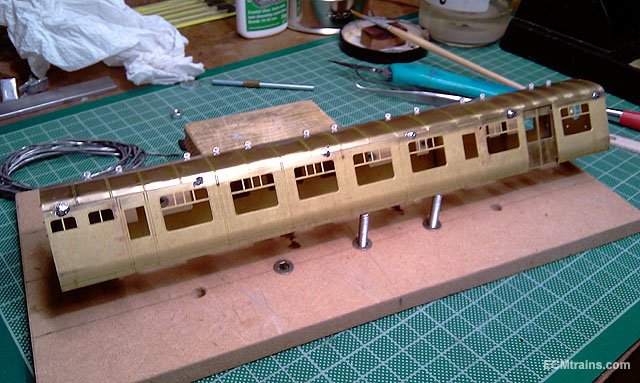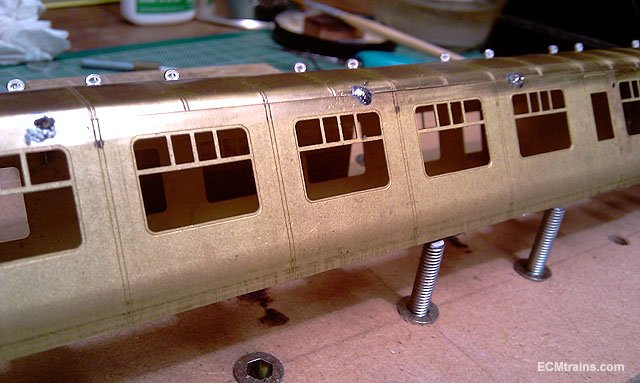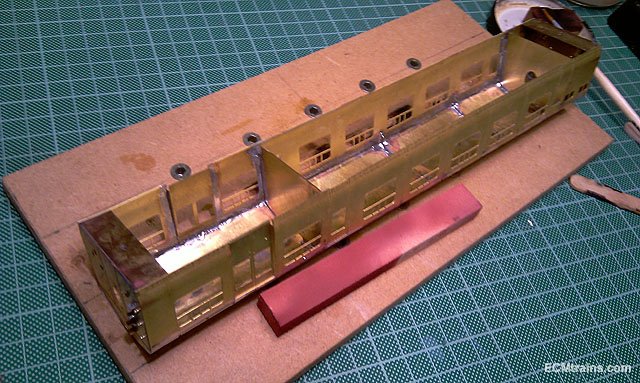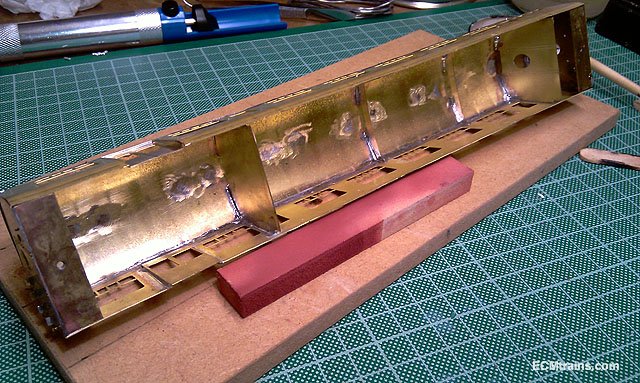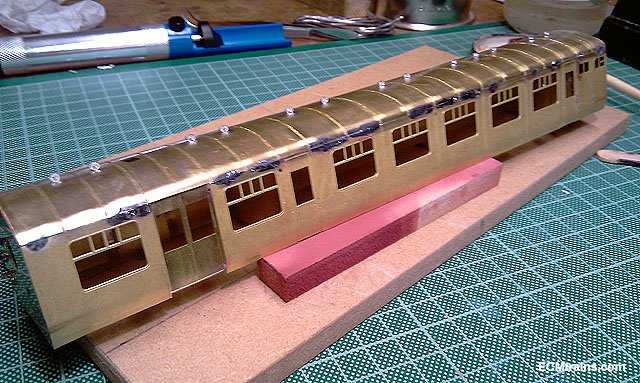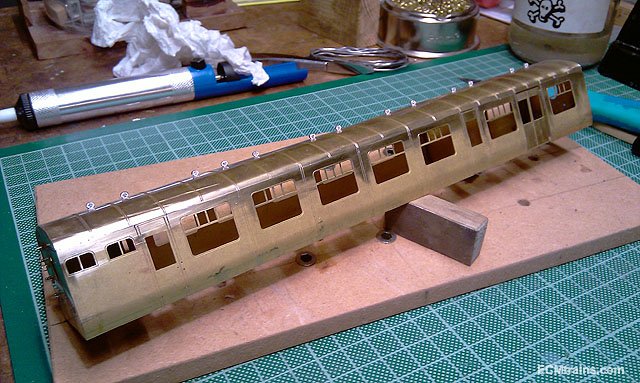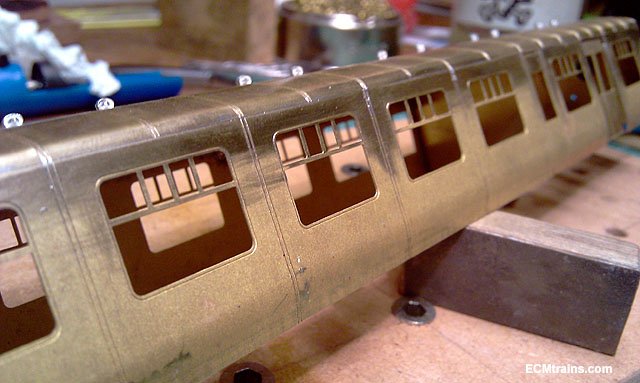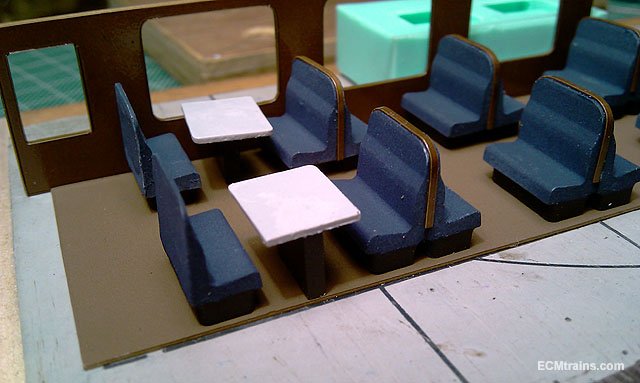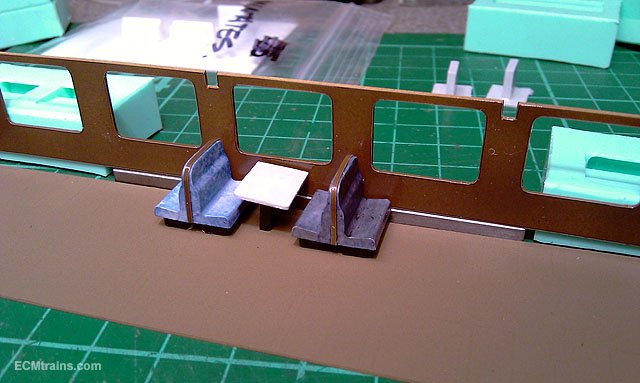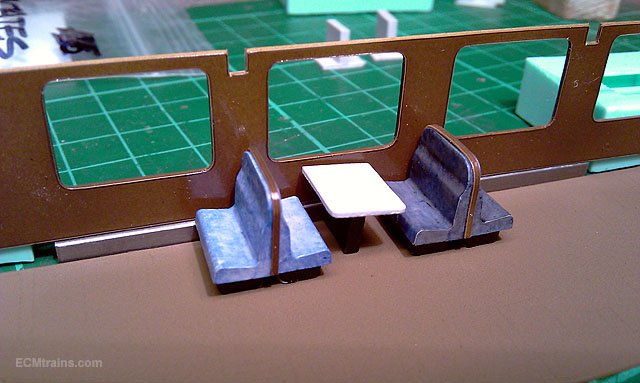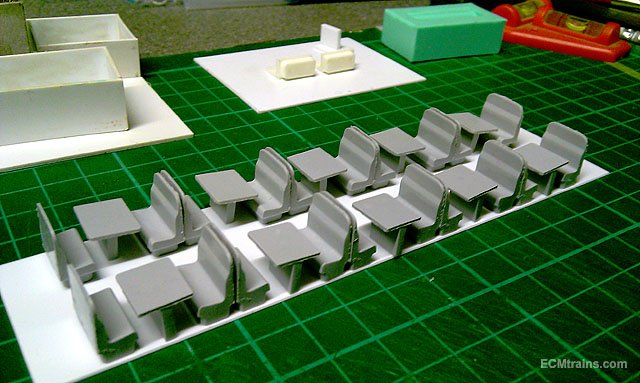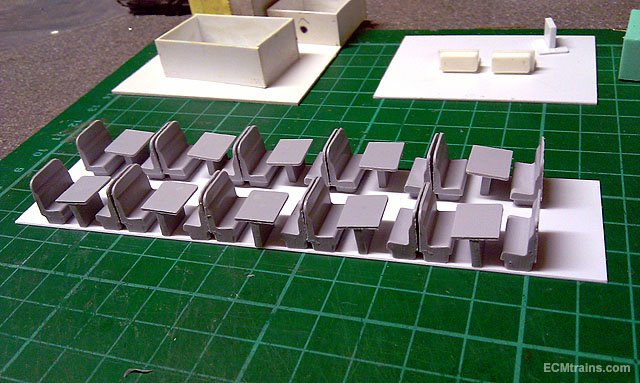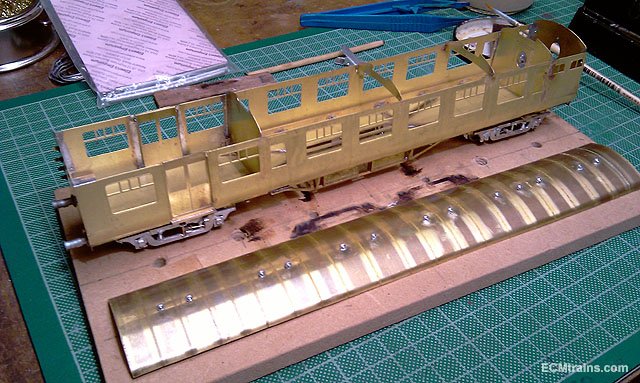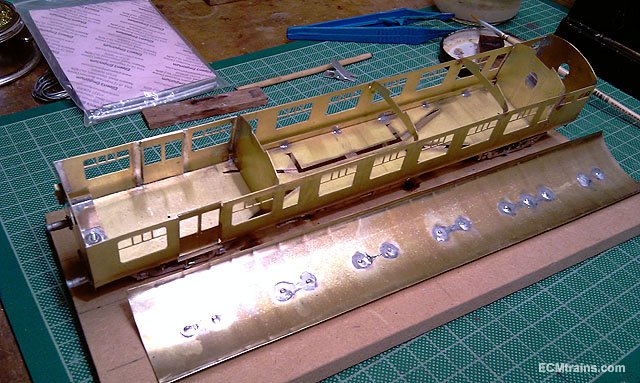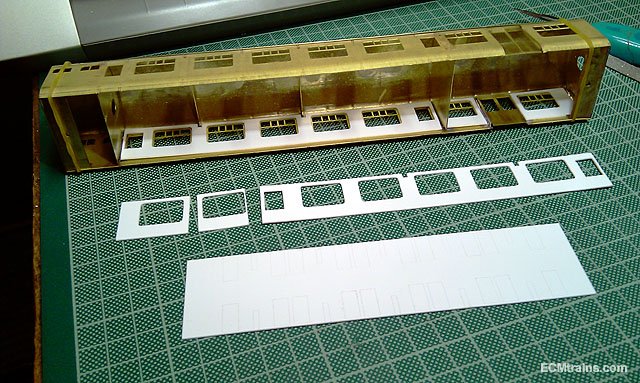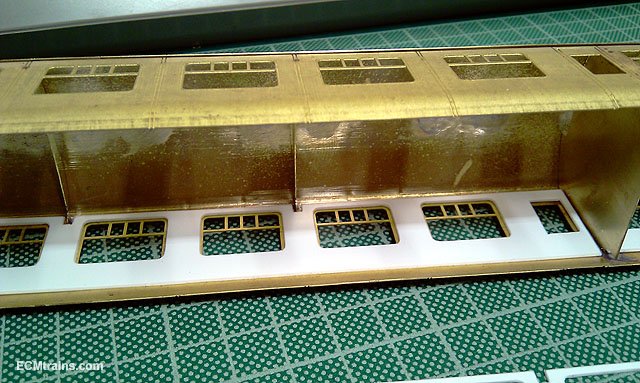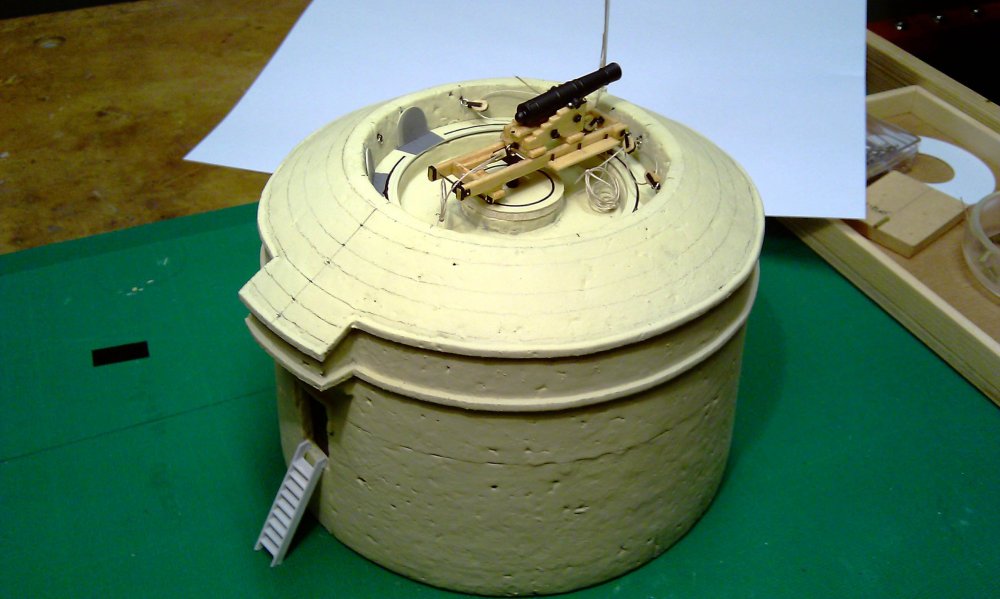-
Posts
2,719 -
Joined
-
Last visited
-
Days Won
70
Content Type
Profiles
Forums
Events
Gallery
Blogs
Store
Community Map
Everything posted by murrayec
-
Train & Model Fair is on this Sunday.
-
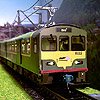
CIE Laminate Coaches - Worsley Works - ECMbuild in 4mm
murrayec replied to murrayec's topic in Irish Models
With the insides sorted its time for the roof to go on the coach body. Stage one- tack solder the roof on in spots on the outside to get everything square. Stage 2 - Solder the roof on from the inside, I worked in small runs of solder, alternating to each end and slowly working to the middle. This minimises heat distortion- taking short breaks gives the assembly a chance to cool down also. The tack solder on the outside melted and some of it ran into the detail lines which will be removed with a scalpel blade. Stage 3 - Clean off the tack solder- first with a solder sucker when the tacks are molten with the iron, then the Dremel with a sanding drum, then fine emery paper, and finally the trusty scratch brush. Roof on and the body is not distorted. A few bits to go on the ends, sort out the corridor connectors and we're painting Eoin -

CIE Laminate Coaches - Worsley Works - ECMbuild in 4mm
murrayec replied to murrayec's topic in Irish Models
Hi John I use a Cameo Silhouette cutter for cutting the plastic card, well it deep scores the card about 3/4 the way through, the blade cannot get through .5mm card, the side of the blade rubs on the side of the cut and wont go any further no matter how many times one re-cuts, so then out with the scalpel to finish off by hand, but very easily done with deep guides to follow, with diagonal cuts in the window opes the waste card snaps out along the score. The Cameo Silhouette will cut through .3mm downwards. I now have a drag knife attachment for the cnc machine for cutting right through plastic card up to 1mm thick, I also cut the card with a 2 flute milling cutter but am experiencing heat problems with the card melting and sticking to the tool! I've just invested in an air cooling system to keep heat away from the tool- yet to run tests! But if all works OK I will be able to cut out large chunks of styrene...... The interior lining idea is so that I will get aluminium colour interior frames to the windows when painted up and complete Eoin -

CIE Laminate Coaches - Worsley Works - ECMbuild in 4mm
murrayec replied to murrayec's topic in Irish Models
-
Hi Paddy Sure is- Train & Model Fair is on next Sunday the 17th from 10.30 to 1.30 Eoin
-
Looking great David, I know the feeling on the painting, I'm finishing the Flying Scotsman with the final painting and every time I think its time for top coat I see another gap that needs filling..... This is fun, see what you can do, see what we make- fun Eoin
-
Hi Warb I was in Barrow Street today for a meeting, when parking the car I could have sworn I was in the model...... Eoin
-
Glenderg, I'd love to give it a go! but would need a bigger bench Eoin
-
Hi David JHB would be the man for this question but I believe he is away holidaying at the moment! Hang in there....... Eoin
-

CIE Laminate Coaches - Worsley Works - ECMbuild in 4mm
murrayec replied to murrayec's topic in Irish Models
Hi Glover Yes I think someone posted those photos on the forum somewhere- black n white photos if I remember correctly? The floral pattern is a bit hard to do, so I'm going to stick with the blue material in the RPSI website photo linked in FL's post above. Eoin -

CIE Laminate Coaches - Worsley Works - ECMbuild in 4mm
murrayec replied to murrayec's topic in Irish Models
I went with the later seats as per Mr Brendan McCausland's photo of the interior of a Break Standard on flicker;- I felt the material may have been by Downpatrick rather than CIE, but the seats were easier and quicker to make than the old type with arms! I'll do the blue as per the RPSI photo Eoin -

CIE Laminate Coaches - Worsley Works - ECMbuild in 4mm
murrayec replied to murrayec's topic in Irish Models
Does anybody have a notion on the seat upholstery for the laminates, I read on the forum some time back and I think it was JHB's comment that the seats were 'grey with a blue fleck' or maybe 'charcoal grey with a blue fleck'? Here is a test of both;- Any input is welcome...... Eoin -
Hi Steve That looks great, next step is to see them on a coach... Eoin
- 96 replies
-
Excellent Noel
-
Mr Bob First one is hard to make out if it's a Class D11, or D14, or D15, or ??, I'd go with a D14 - no models for this one, there are Hornby 4-4-0s that could be converted but they are a bit big and require some converting. Second one is a Class J15, - OO Works do a RTR model and Studio Scale Models do a brass kit if your into building kits. The D14s were built from 1886 to 1891! and steam ships in harbour- my guess on period is 1900 to 1920? Eoin
-

CIE Laminate Coaches - Worsley Works - ECMbuild in 4mm
murrayec replied to murrayec's topic in Irish Models
The moulds for the seats n tables are complete and today I spent the morning plastic casting. I made two sets of moulds to speed things up and I will make a big mould from today's casting of 20 seats for the next coach. First castings. The lot cast. A little bit of a clean up on the edges is required, but wont be stuck down until the floor is painted, also as said above I'll use these 20 seats to make a bigger mould first. Eoin -

CIE Laminate Coaches - Worsley Works - ECMbuild in 4mm
murrayec replied to murrayec's topic in Irish Models
Thanks Noel, The glazing will be sandwiched. Eoin -

CIE Laminate Coaches - Worsley Works - ECMbuild in 4mm
murrayec replied to murrayec's topic in Irish Models
So then, I sorted out the partitions height by de-soldering, shimming up and soldering in again, now the body sits on the chassis beautifully. Next up was to prepare the roof by soldering in the torpedo vents, the roof was thinned with 180deg solder and the vents soldered in with 70deg lead solder. A bit of a clean up on the underside of the vents if one should decide to install lights, I also left a cut-out in the top of the partitions and roof bracing for this. The roof is now ready to be nailed on, but a bit of preliminary set-up for the internals is required- easier to test fit and adjust the bits while the roof is off. Internal sides and passenger floor were cut from .5mm styrene sheet. Excellent fit, the inside window frames will work great with this idea and will be painted silver before the glazing and sides go in. Seats and table parts have been made and moulds are cooking to plastic cast up the full set. After this is done and test fitted- its on with the roof and some small bits, then I can start painting. Has anyone got an idea on the toilet water tank fillers? I was thinking of a circular latch cap type of thing and wonder if there was two of them? Eoin -

CIE Laminate Coaches - Worsley Works - ECMbuild in 4mm
murrayec replied to murrayec's topic in Irish Models
Will do Horsetan. Eoin -
Yes, congratulations lads- and this is only year 1 and your in the top 3 Eoin
-
Hi Paddy Thanks for nice comment, The trees are a mixture- bought and home grown. The nice bought ones came from Modelrailbaseboards which are fabulous and made in Poland, there is a bit of a wait when ordered but their worth it. The home grown were done with Woodland Scenic armatures and sea-foam foliage stuck on- their a pretty close match to the bought ones, there should be a few pictures back up the thread..... Eoin Hi Irishrailwayman Your the second chap thinking its the Glen of the Downs, we did buy it because we also thought of the Downs It's from Expo Tools - 95281 Hills & Dales, we bought 2 of them, it comes in 2 sheets each and we used 3 sheets for the length of the layout, one of the bridges & trees masks the join.... Eoin
-

CIE Laminate Coaches - Worsley Works - ECMbuild in 4mm
murrayec replied to murrayec's topic in Irish Models
Excellent fl, thanks -

CIE Laminate Coaches - Worsley Works - ECMbuild in 4mm
murrayec replied to murrayec's topic in Irish Models
Hi Guys, Here is another question on the laminate coach;- Does the public emergency break system come out both ends of the coach? looking at the laminate photos some ends do not have the system! which leads me to believe it's at one end only!! What do we reckon? Eoin -
.png.c363cdf5c3fb7955cd92a55eb6dbbae0.png)


